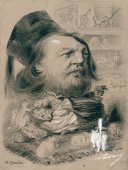Théophile Gautier (1811-1872) with a scarf and a white jacket
Félix Nadar, around 1855
Albumen print from a silver gelatin glass negative,
22.3 × 16.2
22.3 × 16.2
Paris, Musée d’Orsay, acquired with the support of the Cultural Heritage Fund, 1991, PHO 1991 2 74
Photo © Musée d’Orsay, dist. RMN-Grand Palais / Hervé Lewandowski
Théophile Gautier belonged to a different bohemian set than Nadar, his, known as the Doyenné, was described by Gérard de Nerval in his Petits Châteaux de Bohême (Small Bohemian Castles). He was however, very close to the younger set, as well as being an extremely productive journalist who supported them, in addition to Nadar. Something of a role model for the 1840s generation, Nadar devoted the third portrait in his series for the Journal Amusant, "Nadar's Contemporaries" (November 6, 1858) to him. Théo's eccentricities, his fez and his warmth and good cheer fit in perfectly with the bohemian culture of Nadar's day, and he often portrayed the older man as a pasha. Behind the cartoonish image, the "impeccable poet," on a perpetual quest for form and beauty, was seen as an authentic example of a person with high artistic standards.
© BnF, Éditions multimédias, 2018
